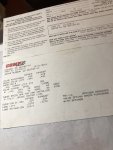Thanks all, it is all new to me so just trying to get any info I can . Re the size of power valve , from a detectives point of view , surely , if it was too large then it would have been this way all the time, they ran it for 4000miles in the us with out issue and it was fine when I got it, something has changed surely, ? I think I should replace like for like to see if it cures the problem, then run the car for a bit and can always go smaller later as not a dear part. Saying that, I dont know what mpg I should expect with this motor ? would a smaller pv improve things without lowering performance.?
the po and his son seem very experienced so I wonder why they went so big, maybe I should ask the thinking behind it?

Thanks all



